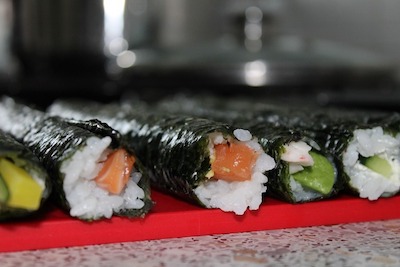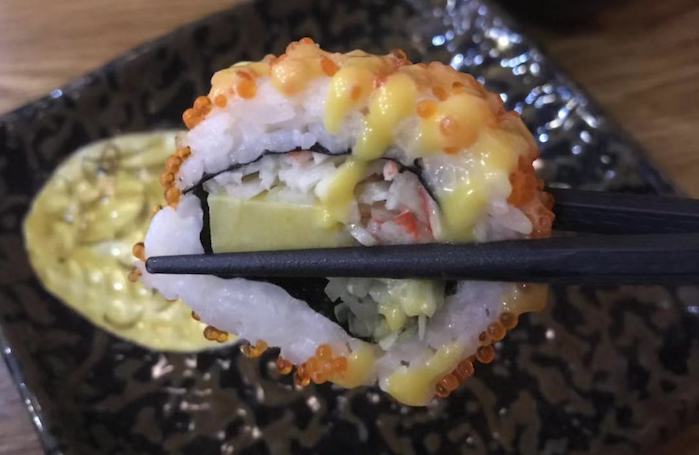We are reader supported. When you purchase through links on our site, we may earn an affiliate commission. Also, as an Amazon affiliate, we earn from qualifying purchases.

If you are a big fan of sushi like me then you are probably guilty of having a date with King crab sushi rolls or smoked salmon rolls with a platter of sashimi twice or even thrice a week. Sushi is just too good to resist, isn’t it? And, it’s easy to lose the count of how many you eat in a week when you want to have it every other day.
How often can you eat sushi? According to a registered dietician, healthy adults can safely consume 2-3 sushi rolls, which means 10-15 pieces of sushi per week. However, the statistics are different for the elderly, pregnant women and others with the compromised digestive system.
It may also vary depending upon the type of sushi you eat. For example, too much raw fish may put your health at risk and fried tempura rolls are not a healthy option. Furthermore, there are some species of fish that are low in mercury, while others carry a higher percentage of mercury risk. Let’s take a closer look at them.
Contents
Truth About Raw Fish In Sushi

How often can you eat sushi containing raw fish like tuna, salmon, or yellowtail without worrying about falling sick? Studies show that fish are packed with omega-3 fatty acids, which is good for health and fights various types of diseases. So, aren’t raw fish sushi supposed to be healthy?
Well, fish is highly nutritious and frying/ grilling destroys some of the healthy fats so raw fish is the epitome of omega-3 fatty acids, but there’s a catch here. Don’t forget that you’re not just eating the fish in sushi but it’s bathed in soy sauce, mayo, and other types of creamy sauces.
A piece of raw tuna is not equally nutritious as the one marinated or doused in sauces. Do you know that a fried tempura roll can set you back for about 500 calories? The health benefits of raw seafood are outweighed when you compare them to sushi. So, what looks good on the front isn’t really the same when you dig deeper?
As per the Dietary Guidelines for Americans, healthy people can consume about 8 to 12 ounces of fish and seafood every week. Some of the common fish used in sushi are salmon, tuna, hamachi, yellowtail, snapper, and mackerel.
Potential Risks Of Eating Raw Fish
Bacteria and Parasites
If you indulge in eating too much sushi containing raw fish at various restaurants, you may welcome the nasty parasites in your gut. If you accidentally consume raw fish that has gone bad, you will be exposed to bacteria and worms. There are numerous cases of people suffering from food borne illness and contaminating bacterial infection from sushi.
So, should you be worried about your sushi roll? Nah! Not really, if you stick to eating only at the popular and trusted sushi restaurants. The good eateries always use sushi-grade fish that have been flash frozen after they were caught to kill any parasites.
If you are making sushi at home, make sure you buy only the highest quality raw fish from a trusted fishmonger. I have created an article that explains the things to consider when buying sushi-grade fish and how to tell if a fish has gone bad.
Practice the right method to thaw and store raw fish at home. Buy only as much sushi-grade fish as you can consume for dinner so that there are no leftovers. If at all you have excess raw fish, cook it the next day to a minimum temperature of 145° Fahrenheit to negate the risk of parasites.
Mercury Risk In Fish
If you eat fish often, I am sure you have heard about risks regarding high mercury levels found in certain fish. Low mercury poisoning may cause discomfort like dizziness and headaches, while severe cases may result in brain damage, developmental delays, and organ failure. Does eating sushi containing raw fish make you vulnerable to that risk?
To being with, not all types of fish come with the same level of mercury risk. Those on the higher end of the food chain (for example, a shark that eats smaller fish) have higher levels of mercury that don’t leave the body once you ingest it.
You must moderate your consumption of bigger fish such as swordfish, ahi tuna, mackerel, and sea bass. Restrict them to only twice per week. On the other hand, it’s safer to eat sushi that contains smaller fish or seafood like salmon, eel, crab, and shrimp.
Besides the size of fish, mercury level also depends upon the environment of the fish. For example, the wild-caught fish of the same species may have 2-12 times more mercury than the farmed versions.
What About People Belonging To High-Risk Group
How often can you eat sushi if you belong to the high-risk group, such as individuals with weakened immune systems, elderly, young children, and pregnant women? It is in the best interest of pregnant women and babies to avoid eating raw fish altogether as a parasitic infection or mercury ingestion can turn out to be fatal.
According to the FDA, pregnant women can safely eat about 2-3 servings of low-mercury fish per week, but the fish should be well cooked. So, you can still enjoy a fair share of cooked sushi rolls and gorge on as much vegetable rolls as you wish. I have created an article that contains 11 easy cooked sushi recipes you can try at home.
The fish with high mercury levels that must be avoided in pregnancy are bigeye tuna, king mackerel, shark, swordfish, tilefish, and orange roughy. Safest species are salmon, herring, cod, flounder, whitefish, Pollock, tilapia, crawfish, catfish, haddock, scallop, squid, and lobster.
Enjoy A Varied Diet With Vegetable Sushi Rolls

I know you can’t live without a spicy tuna roll, but really sushi does not have to be only raw fish and seafood. There are numerous cooked sushi options and vegetable variations that can considerably lower the risks associated with eating sushi, thus allowing you to consume more of the delicacy per week.
If you are a sushi aficionado, the key is to eat a combination of different types of sushi rolls. As per the health nutritionists, all individuals must follow a varied diet comprising of fresh fruits, vegetables, and healthy fats. So, load up your sushi with fillings like avocado, carrots, cucumber, tofu, spinach, scallions, sweet potato and so on.
Sushi Rolls: The Good And Not-So-Good For You Health
As per health experts, it’s not the sushi but the choices of fillings and toppings that make sushi good or bad for your health. So, if you are worried about how often you can eat sushi in a week, just make sure you consciously make the right choices or mix up both
The Good Sushi Rolls
Sushi is typically a low-calorie food as long as you don’t add fried fillings or slather it with sauces of all kinds. Raw fish does not add calories but they may put you at risk of a bacterial infection or mercury ingestion, so eating them in moderation is a wise thing. Here are some good sushi rolls you can eat often without much guilt:

California Roll: They typically contain sushi rice, nori, cucumber, avocado, and crab (cooked real crab or imitation crab). It is often prepared in inside-out style with avocado slices on the top. It is a healthy option if you stay away from the fatty mayo dips and sauces.
Rainbow Roll: Sushi made with raw salmon and tuna are excellent as they are low in calories and rich in protein. Rainbow roll typically contains sushi rice, nori, tuna, salmon, and avocado. Vegan options for rainbow rolls may contain carrots, strawberry, avocado, and cucumber.
Salmon-avocado sushi rolls: This is an iconic combination as both are rich in omega-3 fats and they melt inside the mouth. Both are good for heart health and they help in making you feel fuller for longer. Just like salmon rolls, tuna-cucumber or tuna-avocado rolls (without spicy sauces) are healthy options.
Yellowtail sushi roll: It can be found in almost every sushi restaurant. Although simple, this is a delicious sushi roll that may be paired up with scallions or cucumbers. Yellowtail is a good source of omega-3 fatty acids and contains almost no calories. See more.
Vegetable rolls: Sushi doesn’t have to be all raw fish as there are numerous vegetarian and vegan options that you can choose without any restrictions. Although avocados and cucumbers are the most common options, many veggie rolls include scallions, jalapenos, carrots, mushrooms, spinach, bell peppers, and so on.

Temaki (Hand Rolls): When you wish to reduce the carbs intake but still want to enjoy more sushi in your diet, opt for temaki sushi. These hand rolls may contain less to no sushi rice, and a selection of raw fish and veggies rolled in seaweed.
The Not-So-Good Sushi Rolls
I would not call these sushi rolls bad as I love enjoying their savory taste once in a week or two weeks. However, if you have cholesterol or other health issues, you may want to limit their intake or avoid them altogether.
Philadelphia rolls: They taste heavenly but let’s not forget that they contain cream cheese which is not a healthy choice. The saving grace is that it contains salmon and avocado, but that is outweighed by the saturated fat in cream cheese. If you crave Philly rolls, I would suggest that you make them at home using low-fat cream cheese.
Shrimp-tempura rolls: The seafood is high in protein and tastes great, but it’s comparatively lower in nutritional value. When cooked as tempura, it adds a lot of calories and fat to your meal. I know it’s tough to say ‘no’ to tempura rolls but limit their intake to only once a week.

Dragon rolls: This is a tricky one because when made at home, the dragon roll can be a healthy dish made of eel, cucumber, sushi roll, and nori. However, the restaurant version contains calorie-rich sauce, which lands it in my list of not-so-good sushi and hence must be eaten in moderation.
12 Tips To Eat Sushi And Still Be Safe
- As mentioned above, opt for the good sushi rolls that contain tuna, salmon, and less amount of saturated fats. When making sushi at home, use only sushi-grade raw fish or opt for veggie rolls instead to avoid any health risks.
- Don’t forget the wasabi as it contains a high amount of antioxidants that make your sushi healthy. There’s a reason why it’s there. While you must avoid mixing wasabi with soy sauce as it’s against sushi etiquettes, make sure you add a little wasabi to your rolls for a healthy punch.
- Avoid the crunchy sushi rolls that have been deep-fried to get that golden color and crispy crust on the top. Remember that the less fancy your rolls are, the healthier they will be. So, restrict or completely avoid deep-fried rolls from your diet.
- Focus on ordering sushi rolls that contain raw, grilled, or steamed fish. If you want to cut back on the carbs but still eat more sushi, opt for sashimi that only contains raw fish slices without any additional ingredients.
- When you have already consumed 10-15 pieces of raw fish sushi rolls in a week and still craving for more, opt for the vegetarian options. Order sushi that contains fresh cucumbers, carrots, avocados, and sea vegetables that are packed with nutrients.
- If you wish to limit your white rice intake, ask for brown rice sushi rolls as it contains more fiber, hence easier to digest than the former. You may replace short-grain rice with quinoa, oats, or cauliflower rice when making sushi at home.
- Don’t forget to eat the pickled ginger served with sushi. It is not just for garnishing and cleaning the palate but also aids with digestion.
- When dining at a sushi restaurant, request the chef to use low-sodium soy sauce, which contains 25 percent less salt than the regular soy sauce (shoyu).
- Special sushi rolls taste great but they are often slathered in rich sauces. Ask the server to help you order rolls that do not contain cream cheese or mayo sauce.
- When dining at a sushi restaurant, try eating with chopsticks even if you are not too good at it. This way you will eat slowly compared to eating with a spoon or fork.
- Start your sushi dinner with a bowl of miso soup which will help you fill up faster. So, you will eat less number of rolls and still feel satiated.
- Take care of your serving size with sushi. I would recommend that you stick with one sushi roll, which will be roughly 6-8 pieces. If you are still hungry, fill up with salads and miso soup.
Related Questions
What is a well-balanced sushi meal?
To balance the level of nutrients and reduce your mercury intake, a well-balanced sushi meal should comprise of one roll (6-8 pieces) containing salmon or tuna, and then load up with more cooked and vegetable roll options.
Why you must avoid grocery store sushi
I usually advise people to stay away from grocery-store sushi because they are prepared at a different facility and then brought to the stores. You never know how long it had been sitting on the shelves before you buy it. Better to be safe than sorry. It’s better to eat sushi at a restaurant where you can see the chef make your meal in front of you.
Where can I buy sushi-grade fish?
If you wish to cook your own sushi rolls at home, buy sushi-grade fish from a trusted fishmonger or get it online from Catalina Offshore Products. When you don’t have raw fish but want to cook sushi, try the various veggie options. I have created an article that contains 30 good ideas for sushi roll fillings.
Sources:
https://www.womenshealthmag.com/food/a22139515/sushi-mercury-levels
https://www.webmd.com/diet/ss/slideshow-best-worst-sushi-health
https://www.healthline.com/nutrition/is-sushi-healthy#carbs-and-fiber
https://www.livestrong.com/article/553315-frequent-sushi-consumption
https://oureverydaylife.com/can-i-eat-sushi-twice-a-week-12629098.html

